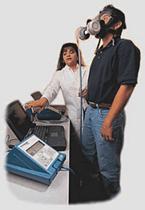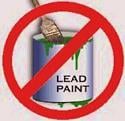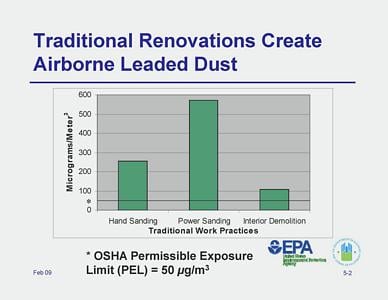Making RRP Easier - New Understandings About RRP Work Practices

Guest Blogger: Dean Lovvorn is a residential remodeler who has done numerous RRP projects. He is also a Lead Inspector, Lead Risk Assessor and EPA RRP Renovator Instructor.
This blog post is a follow-up to a previous RRPedia Guest Blog where Dean listed several differences between the work practices taught in the required Certified Renovator class and what he found is actually required in the RRP rule.
Making RRP Easier - New Understandings About RRP Work Practices

Back in April 2010, I had an exterior remodeling job that was put on hold for a day because of heavy rains. In my boredom, I decided to read the actual RRP law from start to finish. I soon discovered that what I was taught in my 8 hour class and what was in the student manual wasn’t necessarily in the actual law itself.
I was probably dozing off in the 8 hour renovator class, but after these discoveries, I began to clarify some new understandings.
- On exterior containment set-ups, all I really needed to do was put plastic on the ground, be sure windows & doors were closed, cover any doors within 20 feet with plastic and put out a warning sign. If there are no doors and/or windows within 20 feet, simply put plastic on the ground and a warning sign up. Nothing else needed.
- On interior containment set-ups, I just needed to do the same as the exterior (except 6 feet out from where I was working). If there were no furniture/objects or ducts within the 6 foot area … I didn’t have to go any further. Be sure to tape down the plastic on the floor.
Of course, if I was doing some really dusty work, I made the containment (work area) larger, but other than that, it was pretty quick, easy and simple if you were to ask me.
Following are some examples of how reading the actual law has helped me.
Siding Replacement
 In this example, I would place 3.5 mil plastic (from Home Depot), instead of the 6 mil plastic 10 feet out on the ground. Then, I would make sure doors/windows were closed, put plastic over any doors and then put up the warning sign. I would also run a plastic runner out to the dumpster and surround the ground around the dumpster with plastic. Doing the containment this way, saves me from having to wrap, bag or HEPA vac the siding (or myself). This is because I can dump the siding without ever going outside the containment area.
In this example, I would place 3.5 mil plastic (from Home Depot), instead of the 6 mil plastic 10 feet out on the ground. Then, I would make sure doors/windows were closed, put plastic over any doors and then put up the warning sign. I would also run a plastic runner out to the dumpster and surround the ground around the dumpster with plastic. Doing the containment this way, saves me from having to wrap, bag or HEPA vac the siding (or myself). This is because I can dump the siding without ever going outside the containment area.
If exterior vertical containment is needed a simple solution (pictured to right) can be done.
Replacing Door Slabs
If my job is to replace 15 door slabs, I simply do this without following RRP. This is because the only area I am disturbing on each door is the hinge area and since it falls under the Minor Repair and Maintenance Activities, RRP is not required. This insight came from the FAQ section of the EPA web site.
Bathroom Remodel (Total Gut)
 I can demo the tile, tub, shower, toilet and remove the demolition debris without doing any RRP. After that has been done, I cover up ducts with plastic, make sure windows are closed, close doors and cover with plastic, put up a warning sign and then cover the subfloor with plastic (6 feet out from where I will be working).
I can demo the tile, tub, shower, toilet and remove the demolition debris without doing any RRP. After that has been done, I cover up ducts with plastic, make sure windows are closed, close doors and cover with plastic, put up a warning sign and then cover the subfloor with plastic (6 feet out from where I will be working).
I put the demoed walls, cabinets and trim into trash cans (with lids on top) and HEPA vac the outside of the trash cans (along with myself) before taking them out of the containment area.
Note: If I’m lucky and there is an exit door (to the outside) close by … I could run plastic to the door, then outside to the dumpster. This way, I wouldn’t need to worry about containing the demolition debris.
Normally, I do the final clean-up, visual inspection and cleaning verification after demolition; so that I can officially end RRP and let non-certified electricians/plumbers/sub-contractors into the work area.
Conclusion
 It very well could be that if you did a little homework by reading the actual law, you could reduce the cost of compliance on many jobs to less than 5%. Few contractors will lose a job because they are higher by less than 5%. Plus, with the cost less than 5%, I don’t even mention RRP to my clients during the estimation process anymore, which has helped to improve sales.
It very well could be that if you did a little homework by reading the actual law, you could reduce the cost of compliance on many jobs to less than 5%. Few contractors will lose a job because they are higher by less than 5%. Plus, with the cost less than 5%, I don’t even mention RRP to my clients during the estimation process anymore, which has helped to improve sales.
 Posted signs: These must be posted on all sides of the work area to define the work area, must be in the primary language of occupants, must be posted before the beginning of the renovation, and must remain until cleaning verification is achieved.
Posted signs: These must be posted on all sides of the work area to define the work area, must be in the primary language of occupants, must be posted before the beginning of the renovation, and must remain until cleaning verification is achieved. Remove or cover furniture/objects: Remove (preferred) objects like furniture, rugs, window coverings; or cover them with plastic sheeting with all seams and edges taped.
Remove or cover furniture/objects: Remove (preferred) objects like furniture, rugs, window coverings; or cover them with plastic sheeting with all seams and edges taped. Cover duct opening: Close and cover all HVAC vents in the work area with taped down plastic sheeting or other impermeable materials (e.g., magnetic covers).
Cover duct opening: Close and cover all HVAC vents in the work area with taped down plastic sheeting or other impermeable materials (e.g., magnetic covers).
 Looking for accurate information about the EPA RRP rule?
Looking for accurate information about the EPA RRP rule? 

 No, the use of vertical containment is not required for interior jobs, but you can minimize the amount of floor containment needed by making use of vertical containment for interior projects. Floor containment measures may stop at the edge of the vertical barrier when using a vertical containment system consisting of impermeable barriers that extend from the floor to the ceiling and are tightly sealed at joints with the floor, ceiling and walls. One advantage of vertical containment in addition to the reduction of floor area to be covered is the potential reduction of the floor area and other areas that will need to be cleaned on completion of renovations
No, the use of vertical containment is not required for interior jobs, but you can minimize the amount of floor containment needed by making use of vertical containment for interior projects. Floor containment measures may stop at the edge of the vertical barrier when using a vertical containment system consisting of impermeable barriers that extend from the floor to the ceiling and are tightly sealed at joints with the floor, ceiling and walls. One advantage of vertical containment in addition to the reduction of floor area to be covered is the potential reduction of the floor area and other areas that will need to be cleaned on completion of renovations Yes, vertical containment, or an equivalent system of containing the work area, is required for exterior jobs where the property line is within 10 feet of the area of paint disturbance. In addition, vertical containment can also be used to minimize the amount of ground containment needed for a project. Ground containment measures may stop at the edge of the vertical barrier when using a vertical containment system.
Yes, vertical containment, or an equivalent system of containing the work area, is required for exterior jobs where the property line is within 10 feet of the area of paint disturbance. In addition, vertical containment can also be used to minimize the amount of ground containment needed for a project. Ground containment measures may stop at the edge of the vertical barrier when using a vertical containment system. Constructing vertical containment can also allow the contractor to create a sealed working space within a room where the dust can be completely contained to a limited and controlled area. The space created is referred to as a
Constructing vertical containment can also allow the contractor to create a sealed working space within a room where the dust can be completely contained to a limited and controlled area. The space created is referred to as a 

 In this example, I would place 3.5 mil plastic (from Home Depot), instead of the 6 mil plastic 10 feet out on the ground. Then, I would make sure doors/windows were closed, put plastic over any doors and then put up the warning sign. I would also run a plastic runner out to the dumpster and surround the ground around the dumpster with plastic. Doing the containment this way, saves me from having to wrap, bag or HEPA vac the siding (or myself). This is because I can dump the siding without ever going outside the containment area.
In this example, I would place 3.5 mil plastic (from Home Depot), instead of the 6 mil plastic 10 feet out on the ground. Then, I would make sure doors/windows were closed, put plastic over any doors and then put up the warning sign. I would also run a plastic runner out to the dumpster and surround the ground around the dumpster with plastic. Doing the containment this way, saves me from having to wrap, bag or HEPA vac the siding (or myself). This is because I can dump the siding without ever going outside the containment area. I can demo the tile, tub, shower, toilet and remove the demolition debris without doing any RRP. After that has been done, I cover up ducts with plastic, make sure windows are closed, close doors and cover with plastic, put up a warning sign and then cover the subfloor with plastic (6 feet out from where I will be working).
I can demo the tile, tub, shower, toilet and remove the demolition debris without doing any RRP. After that has been done, I cover up ducts with plastic, make sure windows are closed, close doors and cover with plastic, put up a warning sign and then cover the subfloor with plastic (6 feet out from where I will be working).  It very well could be that if you did a little homework by reading the actual law, you could reduce the cost of compliance on many jobs to less than 5%. Few contractors will lose a job because they are higher by less than 5%. Plus, with the cost less than 5%, I don’t even mention RRP to my clients during the estimation process anymore, which has helped to improve sales.
It very well could be that if you did a little homework by reading the actual law, you could reduce the cost of compliance on many jobs to less than 5%. Few contractors will lose a job because they are higher by less than 5%. Plus, with the cost less than 5%, I don’t even mention RRP to my clients during the estimation process anymore, which has helped to improve sales. 

 There was no mention of having to wear disposable suits, dust mask, booties or headwear. (Still might need to comply with OSHA)
There was no mention of having to wear disposable suits, dust mask, booties or headwear. (Still might need to comply with OSHA) It didn’t say I had to use 6 mil plastic, which made me happy since the 3.5 mil plastic sold at Home Depot cost less.
It didn’t say I had to use 6 mil plastic, which made me happy since the 3.5 mil plastic sold at Home Depot cost less.
 Both sides of this issue have valid points to consider. Before we make rash decisions have we looked at the entire picture? We can do better than our politicians, but we must think before we act.
Both sides of this issue have valid points to consider. Before we make rash decisions have we looked at the entire picture? We can do better than our politicians, but we must think before we act. Whether the Opt Out comes back or not, what about the employees of the firms who intend on using this option? Did anyone ask those who are actually doing the work how they feel about their health risks? Will they have a voice without retaliation?
Whether the Opt Out comes back or not, what about the employees of the firms who intend on using this option? Did anyone ask those who are actually doing the work how they feel about their health risks? Will they have a voice without retaliation? I believe this law can create marketing and positioning opportunities to those who see it this way and in the process, keeps everyone safe – and for those who see it differently, it’s obviously a never ending source of complaints which has divided our industry at a time when we need each others’ back more than ever.
I believe this law can create marketing and positioning opportunities to those who see it this way and in the process, keeps everyone safe – and for those who see it differently, it’s obviously a never ending source of complaints which has divided our industry at a time when we need each others’ back more than ever. The following is a partial list of links you can use to find information, resources and instructions for working lead safe. This information can be used by renovators, landlords, tenants and homeowners. I suggest checking them out. I found many good work practices, ideas and options to consider that were not offered or discussed in the required Certified Renovator Training class. Renovators may also find some of the documents valuable to share with prospects and clients when discussing pre-1978 renovations and or if the prospect is considering doing all or part of the work themselves.
The following is a partial list of links you can use to find information, resources and instructions for working lead safe. This information can be used by renovators, landlords, tenants and homeowners. I suggest checking them out. I found many good work practices, ideas and options to consider that were not offered or discussed in the required Certified Renovator Training class. Renovators may also find some of the documents valuable to share with prospects and clients when discussing pre-1978 renovations and or if the prospect is considering doing all or part of the work themselves. Links to Information,Resources and Instructions About Working Lead-Safe
Links to Information,Resources and Instructions About Working Lead-Safe
 The EPA created the RRP Rule because lead is found in many products in homes. Asbestos was also used frequently in homes in similar products such as paint, floor tiles, roofing tiles, and water pipes. It is safe to assume that where lead is present, asbestos is also near. Asbestos is only a serious health hazard when it is disturbed, which means during renovations the fibers may be set airborne and inhaled by workers.
The EPA created the RRP Rule because lead is found in many products in homes. Asbestos was also used frequently in homes in similar products such as paint, floor tiles, roofing tiles, and water pipes. It is safe to assume that where lead is present, asbestos is also near. Asbestos is only a serious health hazard when it is disturbed, which means during renovations the fibers may be set airborne and inhaled by workers.  Assume asbestos is present if you are working with an older home if it has not been tested by the owners
Assume asbestos is present if you are working with an older home if it has not been tested by the owners
 as described within a scope of work for the project, test lead free by a Certified Risk Assessor, Lead Inspector or Certified Renovator
as described within a scope of work for the project, test lead free by a Certified Risk Assessor, Lead Inspector or Certified Renovator From March through June 2011, a dedicated work group of NARI members regularly convened for the purpose of documenting challenges in the application of EPA's Lead Renovation, Repair and Painting Rule (LRRP Rule). NARI's purpose is to convey to the EPA what is working and what is not working in implementation and to make recommendations. The work group identified the following prioritized concerns with recommendations:
From March through June 2011, a dedicated work group of NARI members regularly convened for the purpose of documenting challenges in the application of EPA's Lead Renovation, Repair and Painting Rule (LRRP Rule). NARI's purpose is to convey to the EPA what is working and what is not working in implementation and to make recommendations. The work group identified the following prioritized concerns with recommendations:

 Another key consideration in paint removal is the impact on wood, especially old, more valuable wood. Chemicals leach out natural resins and leave residue even after rinsing. High heat (1,100ºF) guns force paint pigment back into the wood and risk scorching and igniting wood. Sanding and shaving leave gouge and burn marks if not done skillfully. Pressure washing and new steam paint removal methods often leave irregular surface marks in the wood, drive moisture back into the wood, and create layers of “gray wood” which must be scraped away and or they will threaten the adherence of new paint. All of these methods can damage wood.
Another key consideration in paint removal is the impact on wood, especially old, more valuable wood. Chemicals leach out natural resins and leave residue even after rinsing. High heat (1,100ºF) guns force paint pigment back into the wood and risk scorching and igniting wood. Sanding and shaving leave gouge and burn marks if not done skillfully. Pressure washing and new steam paint removal methods often leave irregular surface marks in the wood, drive moisture back into the wood, and create layers of “gray wood” which must be scraped away and or they will threaten the adherence of new paint. All of these methods can damage wood. The time for the entire surface preparation process is reduced using the infrared heat method. Set up, operation, and cleanup are faster than with other methods. There is no extra time for rinsing, neutralization, drying, or sanding the wood; it is immediately ready for primer.
The time for the entire surface preparation process is reduced using the infrared heat method. Set up, operation, and cleanup are faster than with other methods. There is no extra time for rinsing, neutralization, drying, or sanding the wood; it is immediately ready for primer.


